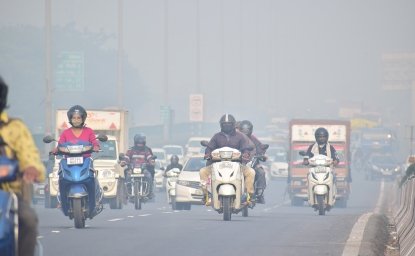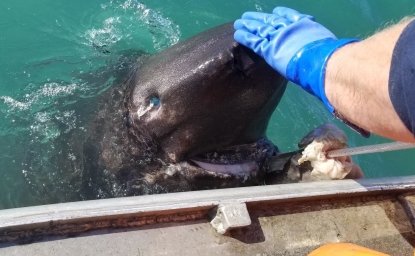Introduction
Thank you to Carl Bruch, Lauren Herzer Risi, Erika Weinthal, and many others. I also want to thank the last panel including General Tom Middendorp, Louise von Schaik, Katarina Kertysova, and the other panelists. Receiving this award is a tremendous honor!
In gathering here together, I am struck by how much the environmental peacebuilding field has grown in a relatively brief period of time. When I was a young professional decades ago, there was no such association, nor any formal connection between environment and peace. While the connections between environmental protection, natural resource conservation, and peacebuilding may seem obvious today, they did not exist in policy or practice a couple of decades ago. All of us are the fortunate beneficiaries of the hard work that Carl, Lauren, Erika, and the other founders of the Environmental Peacebuilding Association have done to advance this field. Through both theory and practice, you have each made the world a better place.
I will note at the outset that Ken Conca and Geoff Dabelko, whom many of you know, and who have been at the forefront of the environmental peacebuilding movement, describe the elements of practice and of research in the environmental peacebuilding field and note these elements played a “chicken and egg” role in the development of this field. I approach this subject more as a practitioner that has used academia to inform and/or reflect policy-making, as you will see demonstrated throughout my remarks. Policymakers need evidence-based scholarship to inform their decision-making. Academics need to understand how institutions work, from government to NGOs to delivery of service.
This afternoon, I will focus my remarks on three elements:
- A brief history of my connection to the environmental peacebuilding field;
- How and why climate change is a “threat multiplier;” or how I became the mother of “climate security;”
and,
- A primary focus on solutions, using a “flip side” of this “threat” framing to tie into environmental peacebuilding and ways that we can use climate and related environment and conservation issues as a “peace multiplier” going forward, including how we can build on all of the great work that everyone in this room already is doing.
I got into public service because my parents are Holocaust refugees who escaped from Nazi Germany in the late 1930s. They were among the fortunate few able to get out. Growing up, I was always taught that you had to do something meaningful to make the world a better place. Learning about the hardships they endured, and the events that led to World War II, influenced me to devote my life to helping others and advancing peace.
From Weapons to Waste: Tracing My Career Trajectory
During the Cold War, advancing peace meant reducing the risks of nuclear weapons, either through arms control, deterrence, or actual elimination. I spent the first part of my career in this field, working as one of the first female professional staff members on the US Senate Armed Services Committee overseeing America’s research into, and development and production of, nuclear weapons. It was during that era of the late 1980s, when my career went from weapons to waste, as the US shuttered its nuclear weapons plants, for environmental, safety, and health lapses. That experience launched the next phase of my career in environmental security, when I became the Pentagon’s first Chief Environmental Officer, with the wonky title of Deputy Undersecretary of Defense (Environmental Security).
At the end of the Cold War, and just after the first Earth Summit in Rio de Janeiro (sometimes referred to as the Rio Earth Summit) in 1992, we were laser-focused on how environment matters to security, both because military activities can be environmentally destructive, and because environmental changes can affect global security. This recognition led to the birth of environmental security. We were cleaning up pollution from military activities and using that knowledge and experience to promote better environmental practices with militaries around the world. Two brief examples include:
The Ambassador from the Chemical Weapons Convention office just talked about getting rid of chemical weapons. At the Pentagon in the 1990s, I was overseeing in part the destruction of the US chemical weapons stockpile. We had eight chemical weapons demilitarization sites. I also engaged with citizen stakeholders and our government regulators as part of the considering environmental factors in chemical weapons destruction. –I even took the EPA Region 9 Administrator out to Johnston Atoll in the remote Pacific so she could see how DOD was meeting environmental requirements for the safe elimination of chemical weapons there. And I live about a mile in Washington DC from the World War One Chemical Munitions training site that was found beneath a field of American University at the time I was serving with the Pentagon and that became its own separate chemical demilitarization activity. We also completed the cleanup at Rocky Mountain Arsenal, which was once an army chemical munitions production site. It is now America’s largest urban wildlife refuge.
Second, during the 1990s, what may seem ancient history now, we were also working with militaries around the world including with Russia, and many of the former Soviet states to share environmental practices. I spoke at many Russian military academies, we had a program with Russia and Norway, and a number of other NATO countries on Arctic Military Environmental Cooperation, where we were working to help the Russians safely reduce the liquid waste streams from decommissioned Russian nuclear submarines that the Norwegians thought could contaminate fishing grounds. And we helped the Russians build a cask so they could safely offload those waste streams instead of letting them leak out and potentially contaminate the area. This approach by the Department of Defense was not only about cleaning up past contaminants, it was also about securing the peace--and we called this approach “preventive defense.” We were working to secure peace and a healthy environment for future generations. Indeed, the motto of my office at the Pentagon on environmental security was "Defending our future." The sustainability element is very much embedded in a concept.
The Emergence of Climate Change as a Security Threat: "Threat Multiplier"
Now, let’s go to climate as a security threat. During and after my time at the Department of Defense, I worked with military leaders from all services, and we asked the question: How will a changing climate affect global security? We wanted to understand the national and global security implications of climate change. So, in 2007, at a time when climate change was primarily the purview of scientists and environmentalists, I organized the first group of generals and admirals to address the national security implications of climate change. We became the CNA Military Advisory Board. Here are some of the questions we examined, with a team of world class scientists, analysts, and senior military leaders:
- What conditions are changes to the climate likely to produce around the world that represent security risks?
- What are the ways in which these conditions will affect global security?
- What actions should we take to address the security consequences of climate change?
We found that:
- Water, food, and energy resources, which are central to survival, are becoming increasingly stressed from climate change.
- Climate change is exacerbating the scarcity of these resources, amplifying competition, and playing a bigger and more complex role in affecting people’s decisions to move within and across state borders.
- These factors increase the risk of political and economic instability, especially in fragile regions, and can become a catalyst for conflict.
- We coined the phrase: “climate as a threat multiplier” to convey how climate acts to amplify and accelerate other security risks we face, from terrorism to strategic competition and weapons of mass destruction.
This first CNA MAB report, which we released just prior to the first United Nations (UN) Security Council session on Climate and Security, together led to the reframing of climate change through a security lens, as well as to climate security emerging as a field of practice and study. Building on my work in environmental security, this framing also worked to mainstream climate and environment into security decision making. Over the last few decades, the military has gone from being an environmental laggard to a climate and clean energy leader.
Connecting the Dots to Environmental Peacebuilding
So how does all of this connect to environmental peacebuilding? First, environmental peacebuilding is defined as “integrat[ing] natural resource management in[to] conflict prevention, mitigation, resolution, and recovery to build resilience in communities affected by conflict.”[1] Further, “[n]atural resources are one of a country’s most critical assets for peacebuilding. . . . Environmental peacebuilding incorporates natural resource management into peacebuilding activities and strategies to support security, humanitarian, and development objectives.”[2] So, the concepts of environmental security, climate security, and environmental peacebuilding clearly are related. Securing the peace is a necessary, but not sufficient, precondition for environmental peacebuilding. That is, one cannot have peace without respective and mutual security. Thus, as an ultimate goal, individuals and nation-states must have energy, water, and climate security to fully achieve peace.
Second, from a historical and policymaking perspective, the environmental security construct of the 1990s and the environmental peacebuilding movement both emerged in parallel and have their roots in the concepts of sustainable development and “preventive defense.” “Preventive defense” is a concept that recognizes that militaries have an important role in promoting peace, trust, and cooperation.
Sustainable development gained traction after the 1992 Earth Summit, and refers, as many of you likely know, to development that occurs in a manner that “meets the needs of the present without compromising the ability of future generations to meet their own needs.”[3] This term and body of work arose because of the earlier history I discussed, in which human development certainly can be, and has been, destructive, rather than sustainable. Sustainability was, and is, embedded in environmental security and climate security.
And, having been present at the creation of the environmental and climate security and environmental peacebuilding fields, I will note that there also is a related environmental justice component that is essential to these concepts. Because communities that are most harmed by environmental damage and consequences tend to be underserved, under-represented, and underprivileged, and because climate change and environmental degradation compound poverty and local fragilities, we all must continue to work to include these very populations and communities in identifying sustainable solutions to these problems, and to our broader environmental peacebuilding efforts.
So what about “Climate-Proofing” security? How can we move from this threat multiplier notion of climate, worsening conflict, to move towards climate as a “peace multiplier”? I would like to share four ways we can we can move towards peace multiplier, and share with you a few thoughts from my forthcoming book, "Threat Multiplier: Climate, Military Leadership, and the Fight for Global Security," which tells the stories of civilians and military leaders around the world as they see climate on the frontlines, from the battlefield to the Pentagon.
Holistic, Cross-Sectoral Solutions are Needed
We need a holistic, cross-sectoral approach to address these complex threats posed by climate change, environmental degradation, and resource scarcity to foster not only adequate, but robust, solutions and to ensure that we have sufficient resources, recognizing these threats will only grow in frequency, severity, and unpredictability. That is, we need the “4 D’s” of defense, development, diplomacy, and disaster risk reduction.
Four Types of Solutions for Moving from “Threat Multiplier” to “Peace Multiplier”
Now, let’s move from “threat multipliers” to “peace multipliers” with particular reference to the role of the environmental peacebuilding community. I recommend four types of solutions for moving from “threat multiplier” to “peace multiplier,” which align with NATO’s climate action plan, and which also are included in my book. These include: education/awareness; mitigation; adaptation; and, reimagining global cooperation.
1. Education/Awareness
In terms of education and awareness-building, two points are paramount.
- It is imperative to shift the narrative. This means we need both to enhance awareness about the causes and outcomes of climate change and to shift the framing from risk to action, and to opportunities for peace. We need to communicate the positive as much as the negative. We need to shift from examining “threat multipliers” to advancing “peace multipliers.”
- It is important to continue coupling advances in physical sciences with the social science research on human behavior. For example, it is not enough to predict rates of drought, we also need to understand human behavior either in adapting more climate-resilient crops or in changing land use patterns. Today, we are still in the early chapters of deploying climate technologies, AI powered and backed by data analytics, to meet human needs. Some call this “actionable” climate intelligence, or improved seasonal to sub-seasonal forecasting.
2. Mitigation
Mitigation refers to finding ways to reduce our carbon pollution to minimize the scale and extent of climate change, and to prevent the worst impacts of climate change from occurring. To move more rapidly to a net-zero world, we need to increase technological innovation across the clean energy transition and ensure that we are acting to decarbonize every sector of society. Last year, the International Military Council on Climate and Security (IMCCS) released an important report on “Decarbonizing Defense.” NATO has ambitious plans to achieve net-zero greenhouse gas emissions by 2050 and is undertaking an energy audit to be able to better manage and plan its greenhouse gas emissions reductions in the future. Security and defense, in democratic societies, cut across many sectors of society, from personnel, to transportation, housing, and infrastructure, and of course weapons systems, are in a good position to “lead by example” in adopting new energy and climate technologies.
3. Adaptation and Resilience
Adaptation refers to the ways in which we will adjust to the climate impacts already baked into the planetary system. Resilience has both human and infrastructure dimensions, from protecting people and troops from hotter and colder temperatures, to ensuring our cities and coastal areas can withstand the next extreme weather event. These considerations are all relevant to environmental peacebuilding, as we also need to protect people, biodiversity, and ecosystems. As is often said, “an ounce of prevention is worth a pound of cure.” Applying this adage to environmental peacebuilding means finding ways to make communities and societies more resilient to a range of risks, from water shortages, and environmental degradation to climate threat multipliers. It’s a matter of either paying now or paying more later. We’re already paying those costs in the multibillion-dollar disasters we experience in our societies every year. So resilience is critical if we’re going to avoid the unmanageable in terms of our climate risks
4. Reimagining Global Cooperation
Finally, we need to reimagine global cooperation. We need inclusive institutions to advance environmental peacebuilding objectives. Let me mention of couple of important ways this should be happening:
- Climatizing Security Institutions. The International Military Council on Climate and Security, which I co-founded with General Tom Middendorp and for which I serve as Secretary General, was one of the pioneers in laying the foundations of this work. The IMCCS consists of a group of senior military leaders and security experts across the globe dedicated to sharing information and best practices to anticipate and address the security risks of a changing climate. As such, it has played a crucial role in building military cooperation on climate change and has laid the foundations for centering environmental peacebuilding efforts in defense and security activities. Indeed, in our IMCCS World Climate and Security Report in 2021, we stated that “climate or environmental peacebuilding measures are often part of a more comprehensive effort to promote peace and stability.” This Report also highlighted the willingness of many militaries to support environmental peacebuilding efforts by civilian actors. The IMCCS has also been at the forefront of supporting and bolstering NATO’s commitment to include climate change in its strategic planning and activities, including by co-hosting roundtables on climate security at recent NATO summits. In fact, we brought a delegation of Young Leaders to the last NATO Public Forum in Vilnius, Lithuania to showcase their experiences and insights on climate security, environmental peacebuilding, and the compound impacts of ecological change.
- We also need to continue to integrate gender and identity into environmental peacebuilding. Indeed, a study I led recently for the US State Department’s International Security Advisory Board on “New Security Challenges,” is one of the first to incorporate gender and identity, climate and resource scarcity, and health and infectious diseases into an assessment of how US diplomacy can better integrate these elements into international security, nonproliferation, and arms control. Doing so is essential, because we know that “[p]eace agreements are far more likely to endure when women and marginalized groups participate” in these processes.[4]
The range of these challenges and achievements reflects the convergence of environmental and climate security with environmental peacebuilding.
Advancing Climate & Environment, Security, and Peacebuilding
Global climate security and environmental peacebuilding require whole-of-society and “all-hands-on-deck” approaches and solutions. While I continue to learn from all of you, I will end by sharing a few action items as “take-aways.”
- Continue to engage in, and learn from, important events, such as this one; and, continue to be leaders in your own communities. The world needs your passion, creativity, and leadership. I, too, am inspired by these traits.
- Be inclusive, or what we sometimes call “silo-busting” in your efforts by involving historically under-represented populations, and by thinking and acting in ways that bridge gaps across traditional divides.
- Integrate innovative approaches into your practices that are environmentally-friendly, climate-resilient, and sustainable, especially with respect to meeting local food and water resource security needs. Here I am motivated by the work of EcoPeace Middle East, a group that has brought together people across a very tough conflict zone to work on water and environmental peacebuilding for a number of years. I applaud that work. It is a good example of bringing together people across tough times to make a difference. Another important example in food security is the U.S. State Department’s Food Security Envoy, Cary Fowler (who founded the Global Seed Bank in Svalbard), who is highlighting some little-known and undervalued crops, particularly in Africa, that require minimal water and are thus more climate resilient. He is calling them “opportunity crops,” because efforts to breed variations could make them even more climate-resilient and help better feed current and future generations, while also providing better nutrition than traditional “big” crops, such as corn and wheat. Picture fields of these “opportunity crops,” including, for example, African eggplant and the grass pea.[5] Picture, too, additional lesser-known “opportunity crops” all of us could cultivate to enhance nutrition and food security in our communities.
Finally, I look forward to sharing my book with you when it is published on August 27. I hope you will find reflected in it versions of your own stories that you are now writing through your own lives, and insights for your future.
I’m impressed by the leadership, passion, and dedication that I’ve seen in so many of you already. I look forward to working with you as we move from a “threat multiplier” to a “peace multiplier” scenario in which environmental peacebuilding will continue to have an important role in our world. We all want to leave a legacy. And now, I’m passing my torch on to each of you.
Thank you again so much for this tremendous honor!
[1] From Environmental Peacebuilding Association’s website: https://www.environmentalpeacebuilding.org/about/.
[2] Ibid.
[3] United Nations. Report of the World Commission on Environment and Development. Our Common Future (Brundtland Report). 1987. https://www.are.admin.ch/are/en/home/media/publications/sustainable-development/brundtland-report.html.
[4] U.S. State Department’s International Security Advisory Board (ISAB). “New Security Challenges” Report Summary.
[5] NPR’s Morning Edition. “Why a campaign has started to bring back some plants that have been forgotten.” Dan Charles. April 18, 2024. https://www.npr.org/2024/04/18/1245495929/why-a-campaign-has-started-to-bring-back-some-plants-that-have-been-forgotten.






